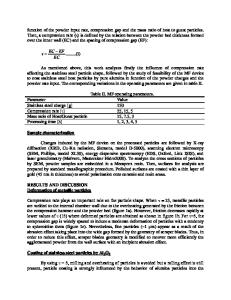Spraying of Metallic Powders by Hybrid Gas/Water Torch and the Effects of Inert Gas Shrouding
- PDF / 1,641,745 Bytes
- 11 Pages / 593.972 x 792 pts Page_size
- 66 Downloads / 290 Views
T. Kavka, J. Mateˇjı´cˇek, P. Ctibor, and M. Hrabovsky´ (Submitted September 15, 2011; in revised form December 8, 2011) A hybrid DC arc plasma torch, combining water and gas stabilization, offers a high flexibility in plasma characteristics. These can be controlled in a wide range by the torch operational parameters, such as arc current and secondary gas flow rate. In this study, their influence on plasma spraying of tungsten and copper was investigated. To suppress the in-flight oxidation of the metals, inert gas shrouding was applied. In-flight particle diagnostics and analysis of free-flight particles and coatings was performed for spraying experiments in the open atmosphere and with argon shrouding. Both in-flight particle behavior and coating properties were found to be sensitive to the torch parameters. The application of shrouding was found to affect particle in-flight parameters, reduce the oxide content in the coatings and generally improve their properties, such as thermal conductivity. However, a different degree of these effects was observed for copper and tungsten.
Keywords
copper, gas shroud, hybrid water-gas plasma torch, plasma facing materials, plasma spraying, tungsten
1. Introduction Plasma sprayed coatings provide surface protection/ enhancement in a wide variety of applications. Properties of the coatings depend both on the chosen feedstock material and the structure of the sprayed coating. The latter can be to a large extent controlled by plasma spraying parameters, such as torch power, plasma gas type, powder injection conditions, spraying pattern, etc. The flexibility of the spraying parameters offers on one hand the possibility to tailor the properties of the coatings for the desired application; on the other hand, this also necessitates a complex study on the influence of these parameters on the coating structure and properties. These can be traced by so-called Ôprocess mapsÕ (Ref 1), linking
This article is an invited paper selected from presentations at the 2011 International Thermal Spray Conference and has been expanded from the original presentation. It is simultaneously published in Thermal Spray 2011: Proceedings of the International Thermal Spray Conference, Hamburg, Germany, September 27-29, 2011, Basil R. Marple, Arvind Agarwal, Margaret M. Hyland, Yuk-Chiu Lau, Chang-Jiu Li, Rogerio S. Lima, and Andre´ McDonald, Ed., ASM International, Materials Park, OH, 2011. T. Kavka and M. Hrabovsky´, Institute of Plasma Physics, Thermal Plasma, Prague, Czech Republic; and J. Mateˇjı´cˇek and P. Ctibor, Institute of Plasma Physics, Materials Engineering, Prague, Czech Republic. Contact e-mail: [email protected].
Journal of Thermal Spray Technology
the spraying parameters to particle in-flight characteristics and those in turn to the relevant properties of the deposits. Besides undergoing phase changes (melting in the plasma and rapid solidification upon impact), the sprayed material may also experience chemical changes. A typical example is oxidation, which inevitably occurs during spray
Data Loading...










